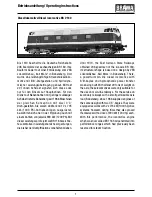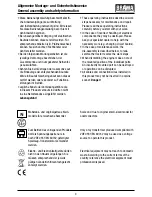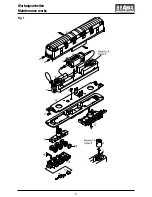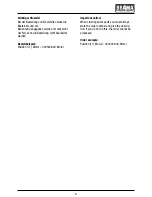
1
Betriebsanleitung/ Operating instructions
Bis 1970 beschaffte die Deutsche Reichsbahn
206 Exemplare der sechsachsigen BR 180. Ihre
Bauform basiert auf einer Entwicklung vom VEB
Lokomotivbau „Karl Marx“ in Babelsberg. Dort
wurde eine leistungsfähige Streckendieselloko-
motive mit B’B’Drehgestellen und hydrodyna-
mischer Leistungsübertragung gebaut. Mit fast
20 Tonnen Achslast eigneten sich diese Loks
nur für den Einsatz auf Hauptbahnen. Für den
Dienst auf Nebenbahnen mit geringer zulässiger
Achslast lieferte Babelsberg seit 1966 Maschinen
der gleichen Konzeption mit zwei C’C’
Drehgestellen. Sie waren ab Werk mit 2 x 735
kW(1000 PS)Antriebsanlagen ausgerüstet,
bewährten sich aber in der Erprobung auch mit
einem Antrieb von jeweils 900 kW (1200 PS). Mit
dieser Leistung war die jetzt als BR 118 bezeichne-
te Lokomotive in Leistungsbereiche vorgedrungen,
die bisher der Dampftraktion vorbehalten blieben.
Diesellokomotive/Diesel locomotive BR V 180
Until 1970, the East German State Railways
obtained 206 specimen of the sixaxle BR 180.
Its structural shape is based on a design by VEB
Lokomotivbau ‚Karl Marx‘ in Babelsberg. There,
a powerful mainline diesel locomotive with
B’B’bogies and hydrodynamic power transfer
was being built. With almost 20 tons of weight on
the axle, these locomotives were only suitable for
the use on mainline railways. For the service on
secondary railways with a small permissible axle
load, Babelsberg since 1966 supplied engines of
the same design with two C’C’bogies. They were
equipped ex works with 2 x 735 kW (1000 hp) drive
systems, however, during trials they also proved
themselves with a drive of 900 kW (1200 hp) each.
With this performance, the locomotive engine
which was now called BR 118 had penetrated into
performance ranges which had previously been
reserved for steam traction.




























